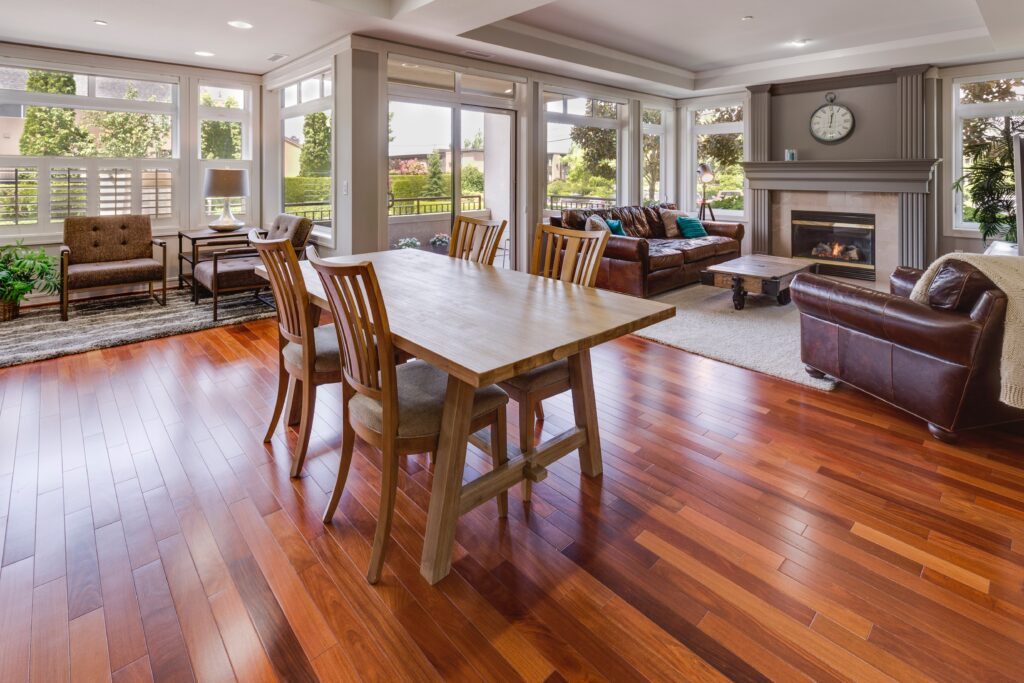Does new flooring increase the value of my home?
May 5, 2022In short, the answer is “yes.” Replacing your old flooring before selling will not only improve the look of your home, but will also increase its resale value.
Realtor.com estimates the return on investment to be 70 to 80% for installing hardwood floors, and suggests that wood floors can boost the sales price of your home as much as 2.5%.
Another survey shows that 54% of home buyers are willing to pay more for hardwood floors when buying a house, adding more than $2,000 to the average sales price of the home.
What type of flooring adds the most value?
While hardwood is definitely “king” among flooring materials, you also have to be smart about your selections. And don’t panic if hardwood is out of your budget range, as there are a number of alternatives that can achieve a new or upgraded look.
Hardwood is timeless and versatile, and also more durable over the long haul than carpet which usually needs to be replaced every 10 years. Recoating hardwood floors every three to five years or refinishing them every eight to 10 years can lengthen their usable live span considerably.
Ceramic tile flooring can also add value to your home if it does not have an outdated style and there aren’t outdated materials in other rooms. While experts agree that hard surfaces improve your home’s appeal and add more value than carpets, room-to-room consistency rates just as high.
Although wall to wall carpeting has not enjoyed the popularity it once had in modern homes, area rugs have certainly stepped up to a more prominent role in home décor, adding splashes of color and uniqueness to hard surface floors.

What is the cost of new flooring?
Solid hardwood flooring, as well as engineered wood floors, can cost anywhere from $9 to $15 per square foot (plus installation), depending on the quality of the wood selected and the finish. The engineered wood floors would fall on the lower side of that range. And although that is quite a wide range, keep in mind that the final cost depends on the type of wood as well as different cuts and degrees of thickness.
What is the difference between solid hardwood and engineered wood?
The easiest way to tell the difference between solid hardwood and engineered hardwood is to look at the side of a loose plank. If it is one solid piece of wood with a continuous grain, it is solid hardwood. If you see different layers of wood it is engineered hardwood.
Solid hardwood comes from a solid piece of milled wood, usually maple, walnut, oak, or cherry. Hardwood flooring installation involves nailing the wood planks to the subfloor, which requires certain skills. Solid hardwood can be sanded easily and refinished several times over its lifespan to maintain its appearance.
Engineered wood flooring is made to look and feel just like hardwood flooring, but its construction uses only a thin layer of hardwood to achieve its appearance and has a plywood core. It is available in glued or interlocking planks that make it easier to install. And because its top layer is thin, it cannot be refinished as often as the solid wood flooring.
When looking at any of the various engineered wood flooring options, including those that are labeled waterproof hardwood flooring, always check the label for performance in a variety of conditions and applications to make sure it is consistent with your plans.
Which one to install where? Engineered wood flooring can be a better option for high moisture environments than solid hardwood, and is often used in kitchens, bathrooms, and basements.
Back to the resale value of your home, hardwood flooring is often considered a premium add-on that can increase the value, based on the longevity of hardwood and the premium quality that are usually strong selling points for a potential buyer.
What are the options other than hardwood or engineered wood?
If you find hardwood to be out of range for your budget, there are a few alternatives to consider:
- Unique wood pieces with character – Since wood is natural in nature, you may find a less expensive piece of wood that has variations in knots, streaks, and color, and with some creativity in finishing, could add a one-of-a-kind uniqueness to your home.
- Sheet vinyl flooring that comes in a range of designs, and even a wood lookalike, may not increase your home’s value but still give it a sparkling new look. Prices on average are $2-4 per square foot plus installation.
- Vinyl plank flooring, which generally runs about $4-6 per square foot plus installation, and is often a DIY project.
And finally, the magic of a flooring makeover for one of your rooms — or even your whole house – can take place in your own living room with Elizabethtown Flooring’s Room Virtualizer. With this tool, you can get a sneak peek at how various flooring materials will look in your own setting. Simply upload a good photograph of your room, and click through the options.
No photo or tech skills? No problem. Simply complete our contact form and provide some information about your project. We will provide a pre-measure estimate by phone or email, and then bring the showroom to you with our Shop-At-Home Program. You can always count on the professionals at Elizabethtown Flooring for all of your of your flooring needs.